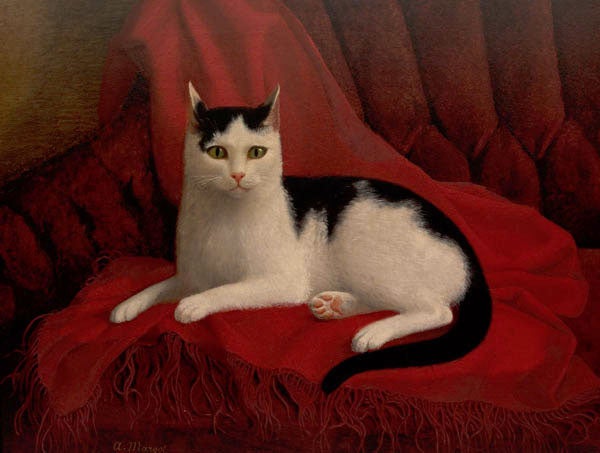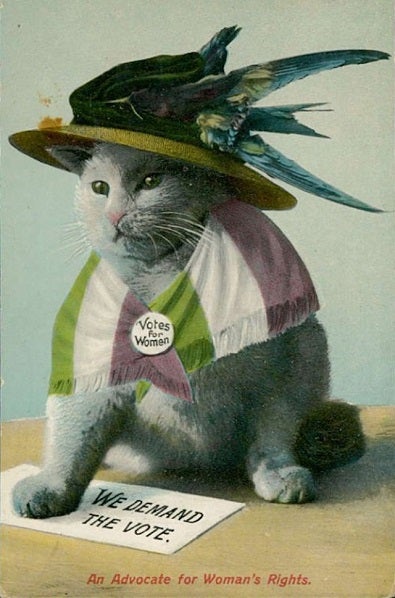By Esther Inglis-Arkell
 You’ve seen them on television. You might know one in real life. Perhaps you even aspire to be one. Cat ladies have been around since time immemorial. This is their story.
You’ve seen them on television. You might know one in real life. Perhaps you even aspire to be one. Cat ladies have been around since time immemorial. This is their story.
Cats were always useful to have around. They were domesticated, and celebrated, in ancient Egypt, where they kept mice at bay. This was not a minor task. Some scholars estimate that one cat, by eating hundreds of mice per year, could save up to 250 tons of grain. But the ancient Egyptians liked cats, and even worshipped them. So a person who cared for cats wouldn’t be out of place.
A lady who liked cats was going to be considered odd by the standards
of the time. And a lady who was considered odd, had a little money to
her name, and no relatives to protect her—well, we all know what
happened to her when witch-hunting season came along. As witch-hunting
became more popular, and more indiscriminate, cat ladies acquired a
touch of the satanic. Ordinary cats were still soulless creatures,
neither good nor bad—but you could never be sure which one of a lady’s
cats was the devil in disguise. Early descriptions of black masses
involve descriptions of a big black cat which the witches would kiss “on
the bottom.” Any kind of behavior could be expected from a cat lady.
Over the years we’ve gotten slightly kinder to cat ladies. Public executions have given way to public mockery. When suffragettes started going on the march, people put up posters of cats demanding the vote in order to show how silly these spoiled women were being. The suffragettes fired back with their own cat cards. Some came with poems like, “I’m a catty suffragette. I scratch and fight the P’lice. So long as they withhold the vote my warfare will not cease.”
When voting was no longer the issue, society simply mocked the cat
lady as a lonely, crazy spinster. There’s the famous cat lady on the
Simpsons, and when Liz Lemon on 30 Rock gives up on ever finding a man, she adopts a cat and calls her “Emily Dickinson.”
Now, though, the cat lady is coming into fashion. Marriage isn’t what it used to be (which might be a good thing). Female independence is becoming more and more glamorous. And if a lady is alone with a houseful of cats—always remember that at least she has a house.
A few cat ladies have become world-famous. There are rich cat ladies. A 19th century cat lady, Kate Birdsall Johnson, recently made the news when a portrait of her cats that she had commissioned sold for $826,000 at auction. Big and Little Edie Beale, the infamous Kennedy relatives, shared their Grey Gardens estate with countless cats.

But cats hold a special attraction for literary types. Harriet
Beecher Stowe was a cat lady, who frequently perched her cat on her
shoulder while she wrote. Emily Bronte loved cats, and wrote an essay in which she defended them from detractors who claimed that they were cruel and aloof. (Given the way she wrote Heathcliff in Wuthering Heights, she might have a different frame of reference for cruelty and aloofness than the rest of us.)
Patricia Highsmith is best known for writing The Talented Mr. Ripley. She gets a lot of press for raising snails as pets, but she was also an avid cat lady, who, according to one friend, “needed cats for psychological balance.” She was also famous for killing off the dogs in her novels—but she wrote only one story about a cat being set upon by a killer. Unlike the dogs, the cat survives.

 You’ve seen them on television. You might know one in real life. Perhaps you even aspire to be one. Cat ladies have been around since time immemorial. This is their story.
You’ve seen them on television. You might know one in real life. Perhaps you even aspire to be one. Cat ladies have been around since time immemorial. This is their story.The Origins of the Cat Lady
The cat lady has a house. It’s a house we don’t want to venture into—especially now that episodes of Hoarders have shown us the horror inside—but still, she’s a home-owner. What’s more, she’s the sole home owner. In order for the cat lady to come into her own, she had to have a house all to herself, in which she could hoard in peace. To find the earliest examples of this, we have to go to the Middle Ages, where women could have a house of their own if they were fortunate enough to be wealthy widows or spinsters.Cats were always useful to have around. They were domesticated, and celebrated, in ancient Egypt, where they kept mice at bay. This was not a minor task. Some scholars estimate that one cat, by eating hundreds of mice per year, could save up to 250 tons of grain. But the ancient Egyptians liked cats, and even worshipped them. So a person who cared for cats wouldn’t be out of place.
But cat ladies first got their reputation for weirdness in medieval
Europe. This was a society in which a woman’s fondness for cats made her
suspect. Before they acquired their demonic reputation, cats were
regarded as soulless beasts. Some people claimed that they, and other
animals, couldn’t feel pain. During the Middle Ages, when people wanted
to make ruckus—during charivaris or other shaming rituals—they would
often pick cats up and rip fur off of them in order to get them to make
noise. It was considered good luck to burn cats, and plenty of people
did just that in order to celebrate a major event or ring in the new
year.
Over the years we’ve gotten slightly kinder to cat ladies. Public executions have given way to public mockery. When suffragettes started going on the march, people put up posters of cats demanding the vote in order to show how silly these spoiled women were being. The suffragettes fired back with their own cat cards. Some came with poems like, “I’m a catty suffragette. I scratch and fight the P’lice. So long as they withhold the vote my warfare will not cease.”
Now, though, the cat lady is coming into fashion. Marriage isn’t what it used to be (which might be a good thing). Female independence is becoming more and more glamorous. And if a lady is alone with a houseful of cats—always remember that at least she has a house.
An All-Star Roster of Cat Ladies
Cat ladies usually acquire local notoriety. Locals in Saginaw, Michigan have rallied to save a historic “cat lady house” from demolition. In the early 1900s, New York saw a protracted legal battle when a cat lady died and left a $150,000 estate to the barber who supplied her with cats instead of her own family. In Rome, a group of dedicated cat ladies takes care of the city’s huge population of strays, which in 1991 was declared part of Rome’s “bio-cultural heritage.”A few cat ladies have become world-famous. There are rich cat ladies. A 19th century cat lady, Kate Birdsall Johnson, recently made the news when a portrait of her cats that she had commissioned sold for $826,000 at auction. Big and Little Edie Beale, the infamous Kennedy relatives, shared their Grey Gardens estate with countless cats.

Some professions seem to attract cat ladies. Clara Barton and
Florence Nightingale were both famous nurses and not-quite-so-famous cat
ladies. Nightingale, towards the end of her life owned seventeen cats
and was tyrannical about getting her attendants to make each cat a
special individual meal, because she believed “cats possess more
sympathy and feeling than human beings.” Barton, a civil war nurse who
founded the American Red Cross, was so famous for loving cats that she
got sent one
by a U.S. senator trying to curry favor. A fellow nurse painted
Barton’s favorite cat, Tommy. The portrait now hangs at the Clara Barton
National Historic Site—a tribute to the achievements of cat ladies.
Patricia Highsmith is best known for writing The Talented Mr. Ripley. She gets a lot of press for raising snails as pets, but she was also an avid cat lady, who, according to one friend, “needed cats for psychological balance.” She was also famous for killing off the dogs in her novels—but she wrote only one story about a cat being set upon by a killer. Unlike the dogs, the cat survives.

There is also one honorary cat lady in history. While many male
authors liked cats—Mark Twain refused to play pool if one of his cats
was sleeping on the pool table—only one male author has a type of cat
named after him. Legend has it that, during his foreign adventures,
Ernest Hemingway got a polydactyl cat from a ship’s captain, and brought
it to Key West, where it spawned a line of six-fingered “Hemingway”
cats. (Actually, genetic testing indicates that Hemingway’s cats come
from a line that arrived in North America long before Hemingway was born
and made its way down to Florida from Nova Scotia.)
Still, his cat-pee soaked writer’s retreat earns him a place in cat
lady history. So don’t let biology hold you back. Anyone can be a cat
lady, if they try hard enough!

No comments:
Post a Comment